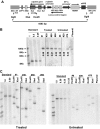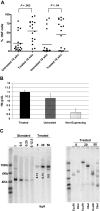Amelioration of murine beta-thalassemia through drug selection of hematopoietic stem cells transduced with a lentiviral vector encoding both gamma-globin and the MGMT drug-resistance gene
- PMID: 19365082
- PMCID: PMC2700315
- DOI: 10.1182/blood-2008-10-186684
Amelioration of murine beta-thalassemia through drug selection of hematopoietic stem cells transduced with a lentiviral vector encoding both gamma-globin and the MGMT drug-resistance gene
Abstract
Correction of murine models of beta-thalassemia has been achieved through high-level globin lentiviral vector gene transfer into mouse hematopoietic stem cells (HSCs). However, transduction of human HSCs is less robust and may be inadequate to achieve therapeutic levels of genetically modified erythroid cells. We therefore developed a double gene lentiviral vector encoding both human gamma-globin under the transcriptional control of erythroid regulatory elements and methylguanine methyltransferase (MGMT), driven by a constitutive cellular promoter. MGMT expression provides cellular resistance to alkylator drugs, which can be administered to kill residual untransduced, diseased HSCs, whereas transduced cells are protected. Mice transplanted with beta-thalassemic HSCs transduced with a gamma-globin/MGMT vector initially had subtherapeutic levels of red cells expressing gamma-globin. To enrich gamma-globin-expressing cells, transplanted mice were treated with the alkylator agent 1,3-bis-chloroethyl-1-nitrosourea. This resulted in significant increases in the number of gamma-globin-expressing red cells and the amount of fetal hemoglobin, leading to resolution of anemia. Selection of transduced HSCs was also obtained when cells were drug-treated before transplantation. Mice that received these cells demonstrated reconstitution with therapeutic levels of gamma-globin-expressing cells. These data suggest that MGMT-based drug selection holds promise as a modality to improve gene therapy for beta-thalassemia.
Figures







Similar articles
-
Lentiviral Transfer of γ-Globin with Fusion Gene NUP98-HOXA10HD Expands Hematopoietic Stem Cells and Ameliorates Murine β-Thalassemia.Mol Ther. 2017 Mar 1;25(3):593-605. doi: 10.1016/j.ymthe.2017.01.019. Epub 2017 Feb 9. Mol Ther. 2017. PMID: 28190779 Free PMC article.
-
Successful treatment of murine beta-thalassemia using in vivo selection of genetically modified, drug-resistant hematopoietic stem cells.Blood. 2003 Jul 15;102(2):506-13. doi: 10.1182/blood-2003-03-0677. Epub 2003 Mar 27. Blood. 2003. PMID: 12663444
-
The degree of phenotypic correction of murine beta -thalassemia intermedia following lentiviral-mediated transfer of a human gamma-globin gene is influenced by chromosomal position effects and vector copy number.Blood. 2003 Mar 15;101(6):2175-83. doi: 10.1182/blood-2002-07-2211. Epub 2002 Oct 31. Blood. 2003. PMID: 12411297
-
Successful correction of the human Cooley's anemia beta-thalassemia major phenotype using a lentiviral vector flanked by the chicken hypersensitive site 4 chromatin insulator.Ann N Y Acad Sci. 2005;1054:238-49. doi: 10.1196/annals.1345.030. Ann N Y Acad Sci. 2005. PMID: 16339671 Review.
-
Hematopoietic stem cell gene transfer for the treatment of hemoglobin disorders.Hematology Am Soc Hematol Educ Program. 2009:690-7. doi: 10.1182/asheducation-2009.1.690. Hematology Am Soc Hematol Educ Program. 2009. PMID: 20008255 Review.
Cited by
-
In vivo hematopoietic stem cell gene therapy ameliorates murine thalassemia intermedia.J Clin Invest. 2019 Feb 1;129(2):598-615. doi: 10.1172/JCI122836. Epub 2018 Dec 18. J Clin Invest. 2019. PMID: 30422819 Free PMC article.
-
In vivo enrichment of genetically manipulated platelets corrects the murine hemophilic phenotype and induces immune tolerance even using a low multiplicity of infection.J Thromb Haemost. 2014 Aug;12(8):1283-93. doi: 10.1111/jth.12633. Epub 2014 Jul 17. J Thromb Haemost. 2014. PMID: 24931217 Free PMC article.
-
Lentiviral vectors in gene therapy: their current status and future potential.Arch Immunol Ther Exp (Warsz). 2010 Apr;58(2):107-19. doi: 10.1007/s00005-010-0063-4. Epub 2010 Feb 9. Arch Immunol Ther Exp (Warsz). 2010. PMID: 20143172 Free PMC article. Review.
-
Cell Membrane-associated heparan sulfate is a receptor for prototype foamy virus in human, monkey, and rodent cells.Mol Ther. 2012 Jun;20(6):1158-66. doi: 10.1038/mt.2012.41. Epub 2012 Mar 20. Mol Ther. 2012. PMID: 22434139 Free PMC article.
-
The Ongoing Challenge of Hematopoietic Stem Cell-Based Gene Therapy for β-Thalassemia.Stem Cells Int. 2011;2011:987980. doi: 10.4061/2011/987980. Epub 2011 Nov 13. Stem Cells Int. 2011. PMID: 22190966 Free PMC article.
References
-
- Nienhuis AW. Development of gene therapy for blood disorders. Blood. 2008;111:4431–4444. - PubMed
-
- May C, Rivella S, Callegari J, et al. Therapeutic haemoglobin synthesis in beta-thalassaemic mice expressing lentivirus-encoded human beta-globin. Nature. 2000;406:82–86. - PubMed
-
- Pawliuk R, Westerman KA, Fabry ME, et al. Correction of sickle cell disease in transgenic mouse models by gene therapy. Science. 2001;294:2368–2371. - PubMed
-
- Persons DA, Hargrove PW, Allay ER, Hanawa H, Nienhuis AW. The degree of phenotypic correction of murine beta-thalassemia intermedia following lentiviral-mediated transfer of a human gamma-globin gene is influenced by chromosomal position effects and vector copy number. Blood. 2003;101:2175–2183. - PubMed
Publication types
MeSH terms
Substances
Grants and funding
LinkOut - more resources
Full Text Sources
Other Literature Sources
Medical
Molecular Biology Databases
Research Materials
Miscellaneous

